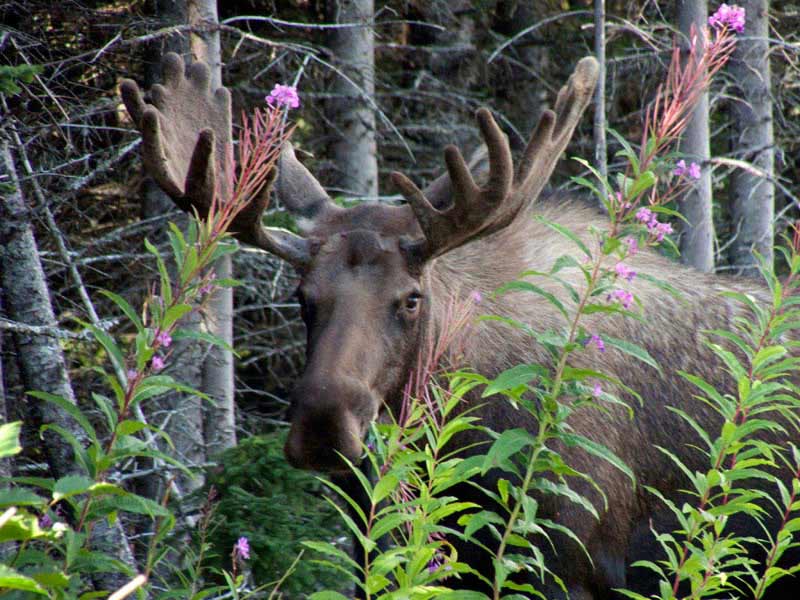For hunters heading out at the start of the fall moose hunting season this week, as in 2013, the odds of getting a moose should be better compared to 2012. Moose hunting opened on Wednesday, Aug. 20, and continues through Sept. 20. After restrictions limiting the take of younger bulls, the bull-cow ratio has improved, the population has increased and the winter survival rate has gone up for Game Management Unit 15C, the lower Kenai Peninsula south of Tustumena Lake.
“It seems to be pretty darn high. We had calves we normally wouldn’t expect to see through the winter still around,” said Jason Herreman of the Alaska Department of Fish and Game and the Homer area biologist. “Overall moose numbers are good down here for the moment.”
For 2013, Fish and Game aerial surveys counted 3,200 moose, with an error of plus or minus 650. In 2012, 350 hunters harvested 25 bull moose. Last year, 825 hunters harvested 112 bull moose. Unit 15C had 56 road-kill moose, about the 5-year average of 54 animals killed yearly on roads.
Last year, regulations were changed to allow taking one bull with a spike on at least one side, 50-inch antlers, or antlers with four or more brow tines on at least one side. Previously hunters could not take spike bull moose. A spike means a bull moose with only one tine on at least one side. Brow tines have to be at least 1-inch long and longer than they are wide. Brow tines also have to come off the brow palm. Distinguishing spikes and brow tines can trip up hunters, Herreman said.
“Some folks didn’t see, or thought it was barely legal and took a chance,” he said.
All antlers have to be sealed within 10 days of harvest at Fish and Game offices. Hunters who make a mistake should report themselves right away.
“It’s best if they truly make a mistake, bring it right down or give us a call,” Herreman said.
Alaska Wildlife Troopers and the courts will go easier on hunters who self-report, said Capt. Bernard Chastain of the wildlife troopers, Anchorage.
“It’s better to harvest the animal and turn it in,” he said. “It’s the ethical thing to do and the right thing to do.”
Hunters who make a mistake forfeit the meat, which is then donated to a charity like senior centers or food pantries. Hunters who see violations can report them to Wildlife Safeguard at 800-478-3377.
Hunters should be aware of private property and where landowners have given permission to hunt.
“What I always tell people is, ‘Get permission first,’” Herreman said. “It keeps people out of trouble.”
“They need to search for private properties themselves,” Chastain said. “It’s their responsibility to know whose land they’re on.”
Alaska Statutes allow access to private property that is not fenced, apparently unimproved or unused, and not posted with a 144-square-inch sign prohibiting access or uses. Chastain said there’s a legal concept called “curtilage,” meaning people have a reasonable expectation of privacy in the area surrounding a house and nearby buildings. Access is prohibited in that area. There’s also the open field doctrine, which allows access to fields beyond a home unless posted. “No trespassing or hunting” signs should be posted at access points, such as driveways, and along property lines.
Fish and Game has been doing a study since March 2012 looking at cow body condition and calf birth and survival rates.
“We’ve got a pretty good feel for what’s going on with how good a condition the animals are in and what their productivity is,” said Thomas McDonough, a Fish and Game research biologist.
In 15C, moose are in relatively better condition than up north in Unit 15A, the northwest Kenai Peninsula. Moose densities are double that in the lower peninsula compared to the upper peninsula. Calf survival over the winter was better in 15C than in 15A, as well as twinning rates. In 15A, more than 36 percent of calves born were twins, while in 15A it was less than 25 percent. After a 1969 fire that rejuvenated moose habitat, by the 1980s twinning rates for 15A were more than 75 percent. Adult moose survival rates are about the same in both areas, but higher in 15C, McDonough said.
Calf survival over the summer and into the winter is related to many different factors, McDonough said.
“The predation level is one factor, but another factor is the condition the cows were in,” he said. “The better the condition the cow is in, the better condition the calf is in, and the faster they can put on weight.”
The severity of a winter, particularly in snow depths, also can be a factor.
“Calves that are in poor condition that are skinnier going into the winter, they’re more susceptible to predation,” McDonough said.
In an area with good habitat and mild winters, cows also can reproduce every year. If the habitat is limited, cows enter what’s called a reproductive pause and aren’t receptive to being bred.
Chastain said that if hunters have questions about regulations, they should contact the local office of the wildlife troopers. On the lower peninsula, that’s the Anchor Point Post on the Sterling Highway in Anchor Point near Chapman School. Chastain also urged hunters to be cautious and safe.
“I would have to reiterate, once they pull that trigger, they own that bullet,” he said. “They have to be doubly sure what they’re shooting at.”
“Be careful,” Herreman said. “Hopefully we’ll have a safe and productive hunting season.”
Michael Armstrong can be reached at michael.armstrong@homernews.com.


